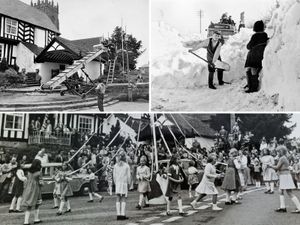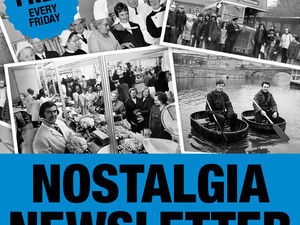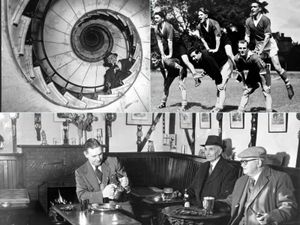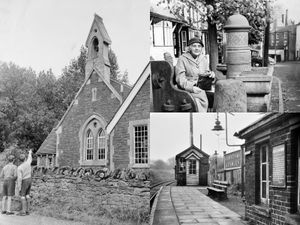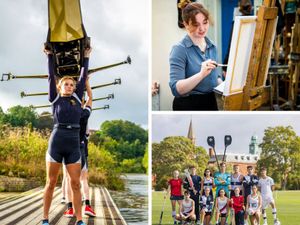As James Oliver inaugurated his great gift to Wellington, he expressed the hope that it would be a boon to the working classes of the town, for whom it was principally intended.
Bid to solve mystery of Wellington's forgotten fountain
He had wanted to open his public drinking fountain privately, but grateful townsfolk would not have it, and made a big fuss.
So on Monday, September 26, 1859, local bigwigs were all there, there was a crowd around the fountain, and the Wellington Amateur Fife Band of Hope and the Wellington Brass Band played stirring airs during a day of celebration which went on into the night.
The fountain was on the corner leading into Station Road, not far from the church lychgate.
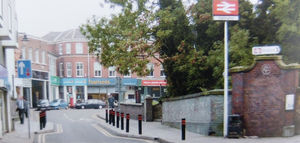
At that ceremony Mr J C Charlton expressed the hope that the tap would “last as long as there were people to drink of its waters.”
He was destined to be disappointed. Today there is just a blank space at the spot where all round good egg Mr Oliver, of Springhill, had formally opened what he claimed to be the first public drinking fountain in Shropshire.
So when did the fountain disappear? Why was it removed? What happened to it? Where is it now?
A local researcher is trying to find more about the fountain story and is hoping that Star readers may be able to help.
Clues are thin on the ground but an old Star photo of the area from December 1967 proves the fountain was missing by that date.
“I am trying to discover when it was removed and where it might be now,” says Andrew Beach.
“The Wellington fountain is of real interest because it was the first drinking fountain in Shropshire and was of a particularly splendid design by the Coalbrookdale Company.
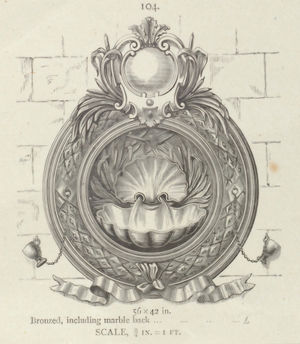
“I have given a presentation to the Wellington History Group about the benefactor of the drinking fountain, an interesting man called James Oliver, and written an article for their magazine ‘Wellingtonia’, part two of which will be in their next edition.”
Andrew is part of a group of members of All Saints Church who are raising money to restore the church’s historic Bevington pipe organ, for which Oliver was the original benefactor, sparking an interest in his largely undiscovered story, which includes his philanthropic act in paying for the drinking fountain.
Anyone who can help with information about the fountain can contact him through organproject@allsaints-wellington.org.uk by email.
The formalities on that day in 1859 climaxed with Mr Oliver filling a goblet of the “fresh, sparkling water” and drinking to the good health of the townspeople.
The contemporary Wellington Journal reported: “Several of the other gentlemen present, following Mr Oliver’s example, replenished the beautifully designed drinking cups (two of which are attached by chains to the fountain) with the liquid and pledged the persons present in a flowing bumper.
“We need scarcely say the juvenile folks had a sharp contest during the remainder of the day as to which would be first to drink the crystal draught, and it was amusing to witness how eager they were to drink at the new fountain.”
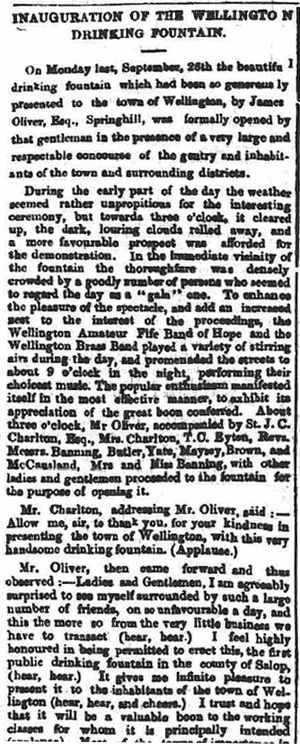
The inauguration of the Wellington fountain came at a time when many towns and cities were doing the same to provide clean drinking water to the populace, which of course had a health benefit, but also was seen in a temperance light.
At the Wellington event a letter was read out from a Mr Crookes of Coalbrookdale - presumably this was Charles Crookes, who was design manager at the Coalbrookdale Company, so may well have designed the fountain, but was unable to attend the ceremony.
In his letter he “sympathised with the movement, believing it to be one in the right direction to check the excessive drinking of intoxicating liquors, which at the present time so widely prevailed, and which (judging from the police reports in the Wellington Journal and other papers) existed in this town as well as other towns in this favoured county.”
Proceedings concluded in traditional fashion, with three cheers for Mr Oliver.
The report mentioned that it was intended that there would be a trough for cattle attached to the fountain at some point.

